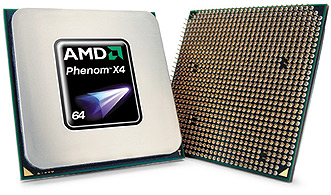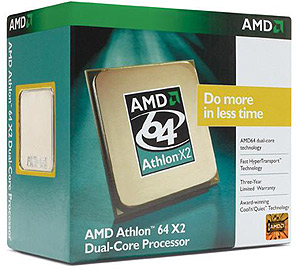For computer enthusiasts, there's been an
age-old debate that dates back to the days when we were forced to carry our bits and bytes
by hand, uphill both ways, in the freezing cold and feed them manually into a
9600 Baud modem.
The argument starts like this: Which is better - AMD or Intel? From there you
can bet opinions differ strongly.
The real answer has changed over the years, depending on who
you talk to and depending on what you want from your computer. It almost always
comes down to which CPU offers the best performance for the kind of work you do, and
how well the computer will stand up over the coming months.
Processors are certainly the most critical part of a computer,
but they hardly work alone. It's nearly impossible to legitimately answer the AMD vs.
Intel question without heavily considering the different platforms supporting each CPU,
and by extension the features you get with one path and lose by not adopting its
nemesis.
"Intel or AMD?" is a question we're asked all the time at
PCSTATS, and a question
that's echoed in computer stores
from here to London, and fought on the
battlegrounds of countless forums… Well, forget everything you've read before, I
have the final, ultimate solution to the Big Green vs. Chipzilla battle royal!
By the end of this article I'm going to tell which CPU is better, and that
knowledge may save you from buying into dead, dying, and prematurely obsolete
processor technology. Atomic batteries to power, turbines to speed, let's
begin!
Round one: AMD vs. Intel - The Mainstream
Choice
When your budget is tight and computer requirements easily satisfied by a mainstream desktop system, answering the AMD
vs. Intel question starts something like this: What's the least expensive CPU with
the most value, and are the platforms for that CPU stacked full of features?
In other words, what's the best bang for buck?
Hands down, for mainstream PC needs the answer is AMD. The AMD Athlon64 X2
4850e that is, and for under $90 bucks it's hard to beat when paired with an AMD
780G based motherboard.
Before you go screaming to the PCSTATS feedback page,
here's
why we picked AMD for our mainstream CPU choice right now.
Technically, the most economical Intel and AMD CPUs on
the market are both suitable for users building budget PCs in the sub-$500
category. Each CPU family is pretty inexpensive, power-efficient, works with
affordable DDR2 memory and can be found in dual and single-core varieties. The
choice gets complicated once you factor in the motherboard platform. Intel's
integrated video chipsets cost more and offer less value than equivalent AMD
integrated boards, while nvidia's recent core logic is simply hard to find.
 Let's take two hypothetical mainstream PCs and compare them so you can see
what I mean when I say AMD is the better buy in this instance.
Let's take two hypothetical mainstream PCs and compare them so you can see
what I mean when I say AMD is the better buy in this instance.
AMD's popular 780G chipset is ideal for
budget-conscious buyers because it offers decent integrated graphics care of the built-in Radeon
3200 GPU. It supports Hybrid Crossfire if you crave better 3D gaming down the road.
Cost wise, it's hard to beat an AMD 780G-based motherboard like the Asus
M3A78-EM (about $100 CDN), paired with the Athlon64 X2 4850e chip. The AMD 780G and
even the newer 790GX variant will get you High Definition home theatre without
any extra cost. That means HDMI output at 1080p with HDCP compliance, 8-channel
audio, gigabit Ethernet and a compact micro-ATX board size to squeeze in
(quietly) next to your stereo
Given the shift away from stand alone DVD players and VCRs to downloaded
digital content, why on earth would anyone want a computer they can't hook up to
their television? Right?
The slightly more expensive AMD 790GX chipset basically just has a faster
graphics processor which is a little better suited to gaming, though it is still
"integrated video". This speed bump isn't worth the extra $80 AMD is asking -
that money would be better spent on a Radeon 4650, which would easily outperform
a 790GX motherboard.
While its gaming performance isn't quite powerful enough to run graphics showcases like Crysis, AMD's
780G integrated Radeon 3200 GPU is capable of smacking around Intel's GMA X4500
HD in World of Warcraft or Call of Duty 4. So there's that too.
In fact, Intel doesn't have a whole lot to offer
those seeking out a motherboard for under $100. Boards based on the Intel
G45 Express chipset, like the
Asus P5Q-EM are available for about $140, have similar features to the AMD 780G,
but lack comparable integrated graphics. The anemic 3D performance offered by Intel's
integrated GMA X4500 HD graphics processor makes even low-end gaming a frustrating,
lackluster experience. Where High Definition content is concerned, both
Intel and AMD platforms fair similarly in terms of HD video quality, so in that
respect you could argue CPU overhead, or just acknowledge that each plays HD
video just fine.
 Fortunately for Intel users, there is a third, albeit untested option -
the nvidia GeForce 9300 chipset. This isn't a discrete graphics card, as the
name might imply, rather it's a new integrated graphics core. The GeForce
9300 puts up better performance in 3D graphics than Intel's GMA X4500 HD,
in some cases slightly faster than AMD's 780G and 790GX platforms, but boards
built on it are still relatively scarce.
Fortunately for Intel users, there is a third, albeit untested option -
the nvidia GeForce 9300 chipset. This isn't a discrete graphics card, as the
name might imply, rather it's a new integrated graphics core. The GeForce
9300 puts up better performance in 3D graphics than Intel's GMA X4500 HD,
in some cases slightly faster than AMD's 780G and 790GX platforms, but boards
built on it are still relatively scarce.
I'd be remiss not to mention Intel's abundance of cheap and cheaper processors.
The Intel Pentium Dual Core E2200 is roughly equivalent to AMD's socket AM2
Athlon64 X2 4850e in both performance and price. Both CPUs cost around $100,
have 1MB L2 cache, are built on the 65nm processes and run at a native 800MHz
bus speed. The Athlon64 X2 4850e is clocked at 2.5GHz, while the Pentium Dual
Core E2200 runs at 2.2GHz, but in real world situations both processors provide
nearly identical performance.
The bottom line is this. Where mainstream computer
requirements are concerned, an AMD CPU and AMD 780G based motherboard just offer
more value
when weighed against a comparable Intel CPU and Intel G45 motherboard. Comparing
the chips alone is another argument entirely, but remember it's not as if you
can use a CPU without a motherboard!
Round two is next, this time PCSTATS tosses two chips into the gaming arena,
and only one will be coming out.

